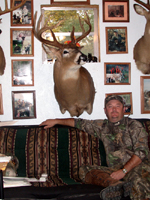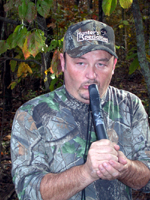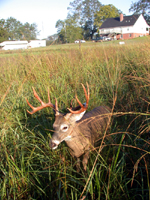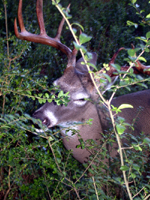
|
Features
|
|
|
|
Books
|
|
|
|
Fun & Games
|
|
|
|
Contact Us
|
|
|
John's Journal... Entry 220, Day 1
SANCTUARY: THE KEY TO TAKING TROPY BUCKS
The Wisdom of the Insane
 Editor's
Note: Trophy bucks don't have to move when you're hunting them. Mature
bucks can find and have everything they need and want after dark - food,
water, sex, companionship, exercise and socialization - without traveling
during daylight hours. Too, older-age-class bucks have learned they're
more likely to encounter predators when the sun goes down. Therefore,
a trophy buck has locating sanctuary - a place where he can stay during
daylight hours and not have to contend with humans - as his number-one
priority. Landowners and hunting clubs that provide sanctuary for bucks
can:
Editor's
Note: Trophy bucks don't have to move when you're hunting them. Mature
bucks can find and have everything they need and want after dark - food,
water, sex, companionship, exercise and socialization - without traveling
during daylight hours. Too, older-age-class bucks have learned they're
more likely to encounter predators when the sun goes down. Therefore,
a trophy buck has locating sanctuary - a place where he can stay during
daylight hours and not have to contend with humans - as his number-one
priority. Landowners and hunting clubs that provide sanctuary for bucks
can:
* pull in older-age-class bucks from surrounding areas that don't have
sanctuaries,
* hold and keep bucks on their lands until those bucks become trophy-sized,
* harvest more older-age-class bucks than surrounding property owners
do and
* build up an inventory of bucks during hunting season.
Most hunters want to know how to provide sanctuary for older-age-class bucks and to harvest them. Also, if you provide sanctuary for older-age-class bucks, how do you maintain the sanctuary and still harvest the big bucks? To learn the answers to these questions, I interviewed several avid hunters and biologists.
 "Alex,
you've lost your mind," I told Alex Rutledge, a member of Hunter's Specialties'
Pro Staff Team, from Birchtree, Missouri. Rutledge had planted a 50-yard-wide
strip of winter wheat all the way around the property line of the 160
acres he hunted. "Your neighbors are going to shoot all the deer coming
from their land to yours. And they're going to shoot across the property
line and kill your deer. Without question, this is the most insane green-field
planting I've ever seen."
"Alex,
you've lost your mind," I told Alex Rutledge, a member of Hunter's Specialties'
Pro Staff Team, from Birchtree, Missouri. Rutledge had planted a 50-yard-wide
strip of winter wheat all the way around the property line of the 160
acres he hunted. "Your neighbors are going to shoot all the deer coming
from their land to yours. And they're going to shoot across the property
line and kill your deer. Without question, this is the most insane green-field
planting I've ever seen."
"Most people would agree with you, John, after first looking at my green field," Rutledge said. "However, I have an agreement with my neighbors not to hunt within 400 yards of my green fields. So by putting a green field just inside my property line, I make sure that my neighbors don't hunt the edge of my land. But you have to see my entire wildlife-management program to understand why I have a green field planted around the edge of my property." As Rutledge explained his management program, I began to understand the wisdom of his insanity. Rutledge had created roads and trails in a design that resembled the spokes of a wheel, with the property's border the outer edge of the wheel. Besides the winter wheat planted on this outer edge of the wheel shape, Rutledge planted the spoke-looking roads, paths and trails coming off this wheel in winter wheat and clover. The 20-acre center or hub of this management program included a thick-cover bedding area and a huge food plot. Rutledge had put several different wildlife plantings in this food plot.
 When
I asked Rutledge why he'd planted more than one crop of deer food in his
sanctuary, he explained, "You know, Bubba, if you eat steak and taters
all day, every day, even though steak and taters are good, you'll get
tired of them after a while. And deer are just like us. They prefer a
smorgasbord where they can pick and choose from a wide variety of foods
when they're ready to eat. I plant this smorgasbord with several varieties
of deer foods twice a year in the center of my property right beside the
bedding-area sanctuary. I make the center green field a part of my sanctuary.
In the fall, I plant turnips, triticales (a cross between wheat and rye),
typhons (a cross between a cabbage and a turnip) and alfalfa, which I
grow all year. I also have clover that grows year-round. For my spring
and summer planting, I use milo and sunflowers, plus I still have my clover
and my alfalfa growing. When a deer comes to my sanctuary, he can feed
any time of the day or night on a wide variety of foods and knows that
no one will mess with him. I only go into my sanctuary to plant crops.
If I shoot a big buck that runs into my sanctuary, I'll go in at night
to find and retrieve that buck. I'll also look for sheds in the sanctuary
during turkey season. But during hunting season, no one, including me,
goes into that sanctuary during daylight hours."
When
I asked Rutledge why he'd planted more than one crop of deer food in his
sanctuary, he explained, "You know, Bubba, if you eat steak and taters
all day, every day, even though steak and taters are good, you'll get
tired of them after a while. And deer are just like us. They prefer a
smorgasbord where they can pick and choose from a wide variety of foods
when they're ready to eat. I plant this smorgasbord with several varieties
of deer foods twice a year in the center of my property right beside the
bedding-area sanctuary. I make the center green field a part of my sanctuary.
In the fall, I plant turnips, triticales (a cross between wheat and rye),
typhons (a cross between a cabbage and a turnip) and alfalfa, which I
grow all year. I also have clover that grows year-round. For my spring
and summer planting, I use milo and sunflowers, plus I still have my clover
and my alfalfa growing. When a deer comes to my sanctuary, he can feed
any time of the day or night on a wide variety of foods and knows that
no one will mess with him. I only go into my sanctuary to plant crops.
If I shoot a big buck that runs into my sanctuary, I'll go in at night
to find and retrieve that buck. I'll also look for sheds in the sanctuary
during turkey season. But during hunting season, no one, including me,
goes into that sanctuary during daylight hours."
Dr. Grant Woods of Reeds Spring, Missouri, a nationally-known wildlife biologist and researcher, believes that Rutledge has hit on two major components needed to make sanctuaries effective for hunting-club members. "To keep the most bucks on your land, the sanctuary needs to be in the center-most part of the property," Woods advised. The deer in a sanctuary need to have little or no human contact. For a sanctuary to be effective year-round, the integrity of that sanctuary can't be violated."
 Rutledge's
sanctuary acts like a buck magnet. The deer from surrounding areas come
to his property and practically line up to feed on the winter wheat. Then
they follow the winter-wheat trails leading from the property line to
his sanctuary fields where he has planted a deer-food smorgasbord. Next
to the smorgasbord, Rutledge has 20 acres of undisturbed thick-bedding
regions. Once a buck arrives at Rutledge's sanctuary, that buck has no
reason to leave. The buck has cover, food and a supply of does that regularly
move in and out of Rutledge's property. Rutledge takes no more than one
or two bucks from his land each year and only hunts the spokes of his
food wheel or the property-line green field. The biggest buck he's taken
has scored 140 points Boone and Crockett. "I've seen bucks that will score
150- to 160-B&C points, traveling to and from my sanctuary, but I haven't
taken a shot at them," Rutledge reported. If you only have a small area
to hunt like Rutledge, you still can produce and hold older-age-class
bucks there, using this spoke-and-wheel type of management system.
Rutledge's
sanctuary acts like a buck magnet. The deer from surrounding areas come
to his property and practically line up to feed on the winter wheat. Then
they follow the winter-wheat trails leading from the property line to
his sanctuary fields where he has planted a deer-food smorgasbord. Next
to the smorgasbord, Rutledge has 20 acres of undisturbed thick-bedding
regions. Once a buck arrives at Rutledge's sanctuary, that buck has no
reason to leave. The buck has cover, food and a supply of does that regularly
move in and out of Rutledge's property. Rutledge takes no more than one
or two bucks from his land each year and only hunts the spokes of his
food wheel or the property-line green field. The biggest buck he's taken
has scored 140 points Boone and Crockett. "I've seen bucks that will score
150- to 160-B&C points, traveling to and from my sanctuary, but I haven't
taken a shot at them," Rutledge reported. If you only have a small area
to hunt like Rutledge, you still can produce and hold older-age-class
bucks there, using this spoke-and-wheel type of management system.
But no deer-management system can promise perfection. "I'm beginning to see a build-up of does on my land and the properties around mine," Rutledge advised. "Until now, I haven't had to harvest any does. This year I will. If I take does from my property-line food plots, I won't destroy the integrity of the sanctuary in the middle of my land. For a sanctuary to continue to produce big bucks, it can't be violated. If you do hunt your sanctuary, don't hunt it but once or twice a year when the wind conditions are right. Then there's a minimum amount of human pressure on that sanctuary."
TOMORROW: THE GALLBERRY THICKET
Check back each day this week for more about SANCTUARY: THE KEY TO TAKING TROPY BUCKS ...
Day 1 - The Wisdom of the
Insane
Day 2 - The Gallberry Thicket
Day 3 - The Price You Pay To Take Bucks
Day 4 - The Docs Speak
Day 5 - Sanctuary to Catch and Keep Your
Neighbor's Bucks